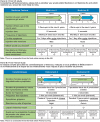PREFERENCES OF PATIENTS WITH MULTIPLE SCLEROSIS FOR ATTRIBUTES OF INJECTABLE MULTIPLE SCLEROSIS TREATMENTS IN THE UNITED KINGDOM AND FRANCE
- PMID: 30251947
- PMCID: PMC6190072
- DOI: 10.1017/S0266462318000491
PREFERENCES OF PATIENTS WITH MULTIPLE SCLEROSIS FOR ATTRIBUTES OF INJECTABLE MULTIPLE SCLEROSIS TREATMENTS IN THE UNITED KINGDOM AND FRANCE
Abstract
Objectives: Adherence to injectable disease-modifying treatments in patients with multiple sclerosis (MS) impacts outcomes and can be influenced by perceptions of treatment efficacy, side effects, injection frequency, and the duration of injection. This study aimed to quantify preferences for selected attributes of injectable treatments among individuals with MS in the United Kingdom and France.
Methods: Respondents with a self-reported diagnosis of MS completed an online discrete-choice-experiment survey, consisting of a series of treatment-choice questions. Each choice question presented two hypothetical treatments, each with six attributes (years until disability progression, relapses in the next 4 years, injection time, injection frequency, flu-like symptoms (FLS), and injection-site reactions), each with various levels. Mixed-logit regression analysis was used to estimate preference weights for attribute levels and to calculate the relative importance of changes in treatment attributes (vertical distance between preference weights). Minimum acceptable efficacy estimates indicate improvement in efficacy that respondents would require in exchange for worsening injection frequency and FLS.
Results: In both countries, 100 respondents completed the survey. In the United Kingdom and France, respectively, improving the time until disability progression from 2 to 4 years, reducing injection frequency from "daily" to "every 2 weeks", and reducing FLS from 3 days after every injection to none had a relative importance of 2.9 and 2.6, 3.0 and 3.5, and 2.5 and 3.1. Given the ranges included in the study, changes in these attributes were more important than most changes in other attributes assessed.
Conclusions: Reductions in the injection frequency of MS treatments and FLS can be as important to patients as improvements in treatment efficacy.
Keywords: adherence; discrete-choice experiment; injectable treatments; multiple sclerosis; stated preference.
Figures
Similar articles
-
Patient Preferences for Injectable Treatments for Multiple Sclerosis in the United States: A Discrete-Choice Experiment.Patient. 2016 Apr;9(2):171-80. doi: 10.1007/s40271-015-0136-x. Patient. 2016. PMID: 26259849 Free PMC article.
-
A discrete-choice experiment to determine patient preferences for injectable multiple sclerosis treatments in Germany.Ther Adv Neurol Disord. 2016 Mar;9(2):95-104. doi: 10.1177/1756285615622736. Epub 2016 Jan 8. Ther Adv Neurol Disord. 2016. PMID: 27006697 Free PMC article.
-
A discrete choice experiment to determine UK patient preference for attributes of disease modifying treatments in Multiple Sclerosis.J Med Econ. 2017 Aug;20(8):863-870. doi: 10.1080/13696998.2017.1336099. Epub 2017 Jun 14. J Med Econ. 2017. PMID: 28562125
-
A Systematic Review of Discrete-Choice Experiments and Conjoint Analysis Studies in People with Multiple Sclerosis.Patient. 2018 Aug;11(4):391-402. doi: 10.1007/s40271-017-0296-y. Patient. 2018. PMID: 29313265
-
Patients' preferences for the treatment of anxiety and depressive disorders: a systematic review of discrete choice experiments.J Med Econ. 2020 Jun;23(6):546-556. doi: 10.1080/13696998.2020.1725022. Epub 2020 Feb 24. J Med Econ. 2020. PMID: 32011209
Cited by
-
The Quality of Life and Medication Adherence in Patients with Multiple Sclerosis-Cross-Sectional Study.Int J Environ Res Public Health. 2022 Nov 5;19(21):14549. doi: 10.3390/ijerph192114549. Int J Environ Res Public Health. 2022. PMID: 36361427 Free PMC article.
-
Patient-based benefit-risk assessment of medicines: development, refinement, and validation of a content search strategy to retrieve relevant studies.J Med Libr Assoc. 2022 Apr 1;110(2):185-204. doi: 10.5195/jmla.2022.1306. J Med Libr Assoc. 2022. PMID: 35440905 Free PMC article.
-
The Evolving Landscape of Discrete Choice Experiments in Health Economics: A Systematic Review.Pharmacoeconomics. 2025 Aug;43(8):879-936. doi: 10.1007/s40273-025-01495-y. Epub 2025 May 21. Pharmacoeconomics. 2025. PMID: 40397369 Free PMC article.
-
Decision Making About Disease-Modifying Treatments for Relapsing-Remitting Multiple Sclerosis: Stated Preferences and Real-World Choices.Patient. 2023 Sep;16(5):457-471. doi: 10.1007/s40271-023-00622-1. Epub 2023 Apr 18. Patient. 2023. PMID: 37072663
-
Patient and physician preferences for multiple sclerosis treatments in Germany: A discrete-choice experiment study.Mult Scler J Exp Transl Clin. 2020 Mar 8;6(1):2055217320910778. doi: 10.1177/2055217320910778. eCollection 2020 Jan-Mar. Mult Scler J Exp Transl Clin. 2020. PMID: 32215218 Free PMC article.
References
-
- Cross AH, Naismith RT. Established and novel disease-modifying treatments in multiple sclerosis. J Intern Med. 2014;275:350-363. - PubMed
-
- Devonshire V, Lapierre Y, Macdonell R, et al. The Global Adherence Project (GAP): A multicenter observational study on adherence to disease-modifying therapies in patients with relapsing-remitting multiple sclerosis. Eur J Neurol. 2011;18:69-77. - PubMed
-
- Treadaway K, Cutter G, Salter A, et al. Factors that influence adherence with disease-modifying therapy in MS. J Neurol. 2009;256:568-576. - PubMed
-
- Giovannoni G, Southam E, Waubant E. Systematic review of disease-modifying therapies to assess unmet needs in multiple sclerosis: Tolerability and adherence. Mult Scler. 2012;18:932-946. - PubMed
MeSH terms
LinkOut - more resources
Full Text Sources
Other Literature Sources
Medical



